Cystophora is a genus of brown algae found mostly in temperate waters around Australia. Most of the southern Australian species can be immediately recognised as belonging to this genus by their characteristic zigzag branching pattern. Identification of individual species is generally more difficult and relies on the size and shape of branches, particularly terminal branches, which are specialised reproductive structures known as receptacles. Due to their local diversity and dominance in southern Australia, they are regarded by some as 'the eucalypts of the underwater world'.

Porphyra is a genus of coldwater seaweeds that grow in cold, shallow seawater. More specifically, it belongs to red algae phylum of laver species, comprising approximately 70 species. It grows in the intertidal zone, typically between the upper intertidal zone and the splash zone in cold waters of temperate oceans. In East Asia, it is used to produce the sea vegetable products nori and gim. There are considered to be 60 to 70 species of Porphyra worldwide and seven around Britain and Ireland where it has been traditionally used to produce edible sea vegetables on the Irish Sea coast.

Chordariaceae is a family of brown algae. Members of this family are may be filamentous, crustose with fused cells at the base, or they may be terete and differentiated into a central medulla and an outer photosynthetic cortex. They have a sporphytic thallus usually aggregated to form a pseudo-parenchyma.
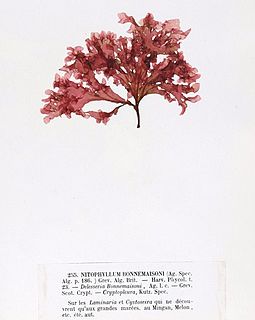
The Delessericaeae is a family of about 100 genera of marine red alga.
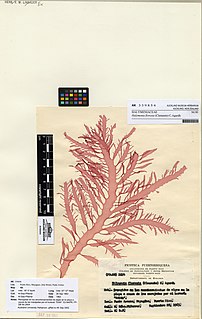
Halymenia a genus of a macroscopic red algae that grows in oceans worldwide. It includes the following species:

Rhodomelaceae is estimated to be the largest red algae family, with about 125 genera and over 700 species.
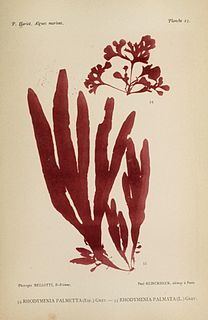
Rhodymenia is a genus of red algae, containing the following species:

Plocamium is a genus of red algae in the family Plocamiaceae. It contains around 40 species and has a cosmopolitan distribution in temperate seas. Plocamium has erect elliptical thalli that grow up to 50 cm (20 in) in length. They are bright red in color with strongly flattened delicately branching fronds that further divide into two to five smaller branchlets.

Laurencia is a genus of red algae that grow in temperate and tropical shore areas, in littoral to sublittoral habitats, at depths up to 65 m (213 ft).
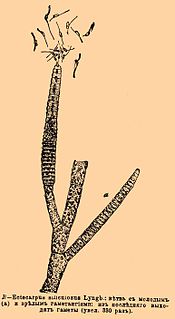
Ectocarpus is a genus of filamentous brown alga that is a model organism for the genomics of multicellularity. Among possible model organisms in the brown algae, Ectocarpus was selected for the relatively small size of its mature thallus and the speed with which it completes its life cycle. The type species for the genus is Ectocarpus siliculosus (Dillwyn) Lyngbye. The life history is an isomorphic to slightly kiheteromorphic alternation of generations, but asexual strains also exist.
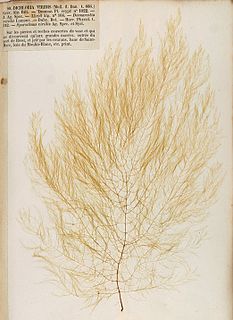
Desmarestia is a genus of brown algae found worldwide. It is also called acid weed, acidweed, oseille de mer, sea sorrel, ウルシグサ, stacheltang, mermaid's hair, landlady's wig, or gruagach. However, 'sea sorrel' can also specifically refer to Desmarestia viridis. Members of this genus can be either annual or perennial. Annual members of this genus store sulfuric acid in intracellular vacuoles. When exposed to air they release the acid, thereby destroying themselves and nearby seaweeds in the process. They are found in shallow intertidal zones.

Rivularia is a genus of cyanobacteria of the family Rivulariaceae.

Hypnea is a genus of red algae, and a well known carrageenophyte.

Phyllophoraceae is a family of red algae in the order Gigartinales.

Phyllophora antarctica is a species of red alga in the family Phyllophoraceae. It is native to Antarctica where it grows in dim light on the underside of sea ice. Some of it becomes detached and accumulates in drifts on the seabed. Many different organisms live attached to the fronds or among them.

Dictyota is a genus of brown seaweed in the family Dictyotaceae. Species are predominantly found in tropical and subtropical seas, and are known to contain numerous chemicals (diterpenes) which have potential medicinal value. As at the end of 2017, some 237 different diterpenes had been identified from across the genus.
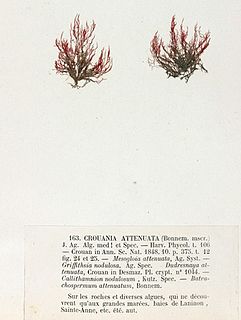
Crouania is a genus of red algae (Rhodophyta) in the Callithamniaceae family. The name of the genus honours the French born Crouan brothers, Pierre-Louis Crouan and Hippolyte-Marie Crouan. It was first described by Jacob Georg Agardh in 1842, and the type species is Crouania attenuata.

















